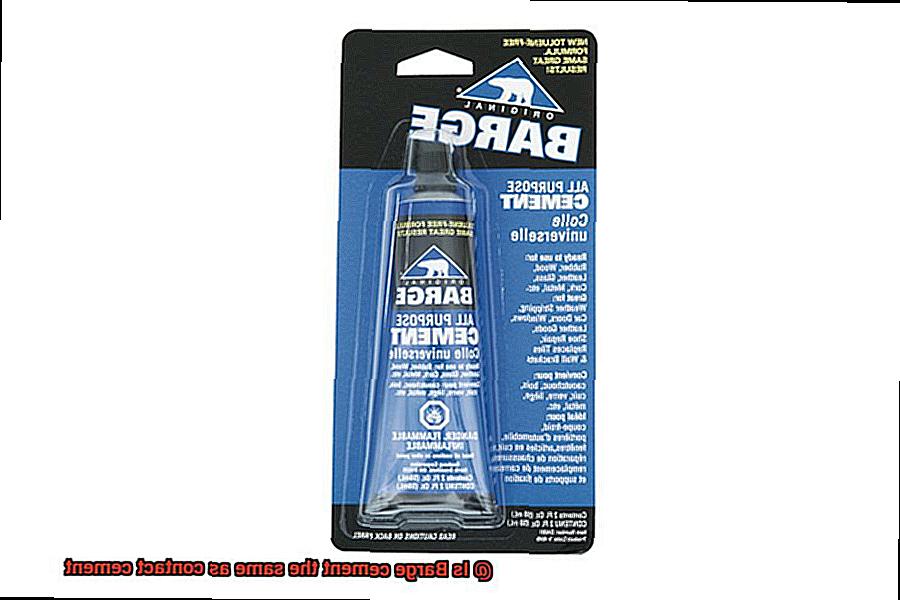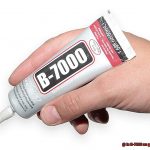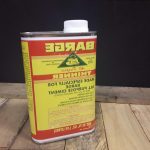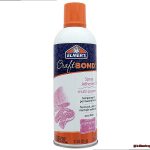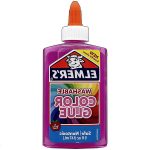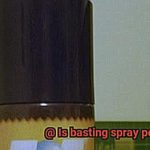Confused by the multitude of cement options out there?
One question that often pops up is, “Is barge cement the same as contact cement?”
Well, they may both be adhesives, but they have distinct differences that can make one better suited for your needs. Barge cement is a superstar when it comes to bonding strength, especially on porous materials like leather.
It’s a go-to for crafters and shoemakers alike. Meanwhile, contact cement offers versatility galore – it can bond wood, plastic, metal, and even fabric.
So if you’re itching to learn more about these two types of cement and figure out which one will work best for your project, keep reading.
Similarities between Barge Cement and Contact Cement
Contents
- 1 Similarities between Barge Cement and Contact Cement
- 2 Differences between Barge Cement and Contact Cement
- 3 Uses of Barge Cement
- 4 Uses of Contact Cement
- 5 Advantages of Barge Cement over Contact Cement
- 6 Disadvantages of Barge Cement compared to Contact Cement
- 7 Tips for Using Barge and Contact Adhesives
- 8 Safety Considerations When Using These Adhesives
- 9 Conclusion
Get ready to dive into the world of adhesives as we unravel the striking similarities that bind Barge Cement and Contact Cement together. These two adhesive powerhouses have earned their reputation in various industries and applications. Join us on this captivating journey as we uncover the shared features and benefits that make them a force to be reckoned with.
Formidable Bonding Abilities:
Prepare to be amazed by the sheer strength of Barge Cement and Contact Cement. Both adhesives boast exceptional bonding properties, creating a firm hold that can withstand the test of time. Whether you’re working on a delicate craft or a heavy-duty construction project, rest assured that these glues have got you covered.
Solvent-Based Marvels:
The magic lies in their solvent-based formula. These adhesives contain solvents that evaporate during the drying process, resulting in a rapid bond formation. Say goodbye to long waiting times. Once cured, these glues provide an unyielding connection that won’t let you down.
Flexibility:
Barge Cement and Contact Cement are masters of adaptability. Their flexible nature allows them to endure movement and stress without compromising their grip. No matter what materials you’re working with, these adhesives will effortlessly keep everything in place.
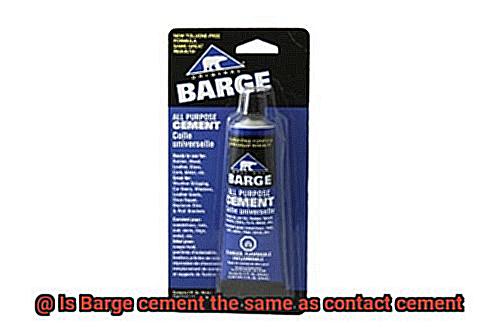
Waterproof Warriors:
Don’t let a little moisture dampen your spirits. Both Barge Cement and Contact Cement are waterproof warriors, making them ideal for outdoor projects or environments prone to moisture. From leather goods to outdoor furniture, these adhesives thrive even when faced with nature’s challenges.
Versatility Unleashed:
Prepare to be amazed by the versatility of these glue superheroes. Barge Cement and Contact Cement can conquer a vast range of materials, including leather, fabric, wood, metal, and plastic. These adhesives are the ultimate sidekicks for industries spanning shoemaking, leatherworking, construction, woodworking, and beyond.
Breath of Fresh Air:
Caution: strong odors ahead. Due to the potent solvents in their formulation, both adhesives require proper ventilation during application. Ensure your safety and comfort by working in a well-ventilated space. Let your creativity soar while keeping those fumes at bay.
Longevity at its Best:
When stored correctly in a cool and dry environment, Barge Cement and Contact Cement have an impressive shelf life. These adhesives are here for the long haul, making them perfect for occasional use or lengthy projects. Say goodbye to constant replacements and hello to reliability.
The Dance of Application:
The secret to their strength lies in the application process. Both adhesives require the generous application of glue on both surfaces to be bonded. After a patient drying period, the surfaces can be joined together, creating an unbreakable bond that will stand the test of time.
Differences between Barge Cement and Contact Cement
Barge Cement and Contact Cement are two adhesive powerhouses that offer exceptional bonding properties and widespread use. However, they have distinct differences that make them suitable for different applications. Let’s explore these differences in more detail.
Ingredients:
- Barge Cement: This trusted brand, with a legacy stretching over 70 years, boasts superior bonding capabilities. Its secret weapon is neoprene, a powerhouse ingredient that delivers unmatched strength and durability.
- Contact Cement: This term encompasses a range of adhesives known for their instant bonding properties. Contact Cement often contains polychloroprene or nitrile rubber, which contribute to its quick-drying nature.

Application Process:
- Barge Cement: To apply this adhesive, you can use a brush or a dauber to spread it evenly on the surfaces to be bonded. This allows for precise application and better control over the amount of glue used.
- Contact Cement: This versatile adhesive can be applied using a brush or a roller, providing flexibility based on the size and type of project.
Drying Time:
- Barge Cement: Patience is key with this adhesive as it typically takes longer to dry compared to Contact Cement. Depending on temperature and humidity, clamping the surfaces together may be necessary to allow the adhesive to fully cure.
- Contact Cement: This superhero forms an instant bond once the surfaces are pressed together, making it ideal for projects that require immediate strength.
Applications:
- Barge Cement: When it comes to heavy-duty projects like shoe repair and leatherwork, Barge Cement is your go-to choice. Its neoprene formulation ensures durability in extreme conditions.
- Contact Cement: Woodworking, laminating, and other applications that demand an immediate bond benefit greatly from Contact Cement’s quick-drying and instant bonding properties.
Uses of Barge Cement
Barge cement, the adhesive superhero of the glue world, has found its way into a multitude of industries and applications. From the cobblers in the shoe and leather industry to the construction workers on job sites, Barge cement is the go-to adhesive for its exceptional bonding strength and versatility.
In the shoe and leather industry, Barge cement reigns supreme. Cobblers rely on this adhesive to attach leather soles to shoes, repair worn-out soles, and add stylish leather trims or patches. With Barge cement, shoes can withstand the daily wear and tear without breaking a sweat.
But Barge cement doesn’t stop at shoes – it also has a special place in the automotive industry. Sagging headliners and loose door panels? No problem. Barge cement securely bonds fabric or vinyl materials to various surfaces in vehicles, eliminating those annoying upholstery issues.
When it comes to construction, Barge cement is like a trusted companion for construction workers. Whether it’s rubber or vinyl flooring materials, laminate countertops, or decorative elements, Barge cement ensures durability and long-lasting results. High-traffic areas are no match for this adhesive powerhouse.
And let’s not forget about the arts and crafts sector. Artists and crafters rejoice. Barge cement is here to save the day by securely bonding fabric, leather, wood, or any other material together. Unleash your creative juices without worrying about your masterpiece falling apart.
Uses of Contact Cement
Contact cement is a versatile adhesive that can do it all. Its strong bonding properties make it a must-have in any toolbox or craft room. Let’s explore the various uses of contact cement in different industries and applications.
In the construction industry, contact cement is the go-to adhesive for bonding materials like wood, laminate, metal, and plastic. It provides a durable bond that can withstand the test of time, whether you’re joining large surfaces or need a reliable adhesive for smaller projects.
The automotive industry also relies on contact cement to bond upholstery materials, such as fabric and leather, to interior components. So next time you’re cruising down the road in your car, you can thank contact cement for keeping your seats intact.
For arts and crafts enthusiasts, contact cement is a game-changer. It bonds materials like paper, cardboard, foam, and fabric, making it perfect for projects that require a strong and permanent bond. From creating custom phone cases to constructing small-scale furniture, contact cement offers reliability and strength for all your creative endeavors.
Woodworkers swear by contact cement for laminating surfaces or joining pieces together. Its quick-drying nature allows for efficient work processes and ensures a strong bond between wood pieces. Plus, contact cement is a popular choice for countertop installation, providing an instant bond for large surface areas.
But the uses of contact cement don’t stop there. It’s also handy for repairing loose tiles, fixing broken furniture, reattaching loose trims or moldings – the possibilities are endless. And did you know that contact cement plays a role in the manufacturing of inflatable products? It’s used to bond different layers of fabric together, creating airtight seals that ensure the product’s integrity.
Advantages of Barge Cement over Contact Cement
In the vast world of adhesives, one product shines brighter than the rest – Barge cement. This superhero adhesive surpasses the versatility and bonding strength of contact cement, making it the ultimate choice for craftsmen, DIY enthusiasts, and professionals alike. Prepare to be amazed as we delve into the extraordinary advantages that set Barge cement apart from its competitors.
Advantage #1: Unyielding Bonding Power
When it comes to bonding materials, Barge cement reigns supreme. Its exceptional adhesive strength creates a bond that is unbreakable and enduring, standing up to the test of time. Whether you’re working with leather, rubber, metal, or any other material, Barge cement ensures a secure hold that never falters.
Advantage #2: The Chameleon-like Versatility
Barge cement is the chameleon of adhesives, adapting effortlessly to any situation. Unlike contact cement, which has limitations in terms of compatible materials, Barge cement is suitable for a wide range of applications. From leather to fabric, wood to plastic, metal to countless other surfaces, this superhero adhesive has got you covered.
Advantage #3: Lightning-fast Drying Time
In the race against time, Barge cement emerges as the victor. Unlike contact cement that demands hours or even overnight for full drying, Barge cement dries within minutes. It’s a game-changer that slashes project completion time dramatically and eliminates tedious waiting periods for the adhesive to set properly.
Advantage #4: Invincible in Extreme Conditions
Barge cement thrives where others fail. It’s an impervious shield against scorching heat and harsh weather conditions. Whether you’re tackling an outdoor project exposed to relentless heat, cold, or moisture, Barge cement remains steadfast in its bond integrity. In comparison, some contact cements crumble and surrender under such circumstances.
Advantage #5: Timeless Shelf Life
In the realm of adhesives, a longer shelf life is akin to an extra life in a video game. Barge cement boasts the ability to be stored for extended periods without losing its effectiveness or adhesive properties. This boon is particularly advantageous for occasional users or those who require adhesive sporadically. With Barge cement, rest assured it will remain efficacious and dependable whenever you call upon it.
Advantage #6: Seamless Application Ease
Barge cement understands the importance of simplicity in application. It arrives in a convenient brush-on form, allowing for precise and controlled application. The adhesive spreads effortlessly and evenly, guaranteeing optimal coverage and avoiding excessive buildup or uneven bonding. Whether you’re a seasoned professional or a novice, Barge cement’s user-friendly application makes it accessible to all.
Disadvantages of Barge Cement compared to Contact Cement
In the world of adhesives, the battle between barge cement and contact cement rages on. While both are commonly used in various industries, it’s important to understand the disadvantages of barge cement when compared to its counterpart. So, let’s dive into the world of glues and explore why contact cement may have the upper hand.
Disadvantage 1: Slow Drying Time
When it comes to drying time, barge cement simply can’t keep up with the lightning-fast speed of contact cement. While contact cement dries in a flash, barge cement takes its sweet time to reach maximum bonding strength. This can be a major setback for projects with tight deadlines or assembly line manufacturing, where every second counts.
Disadvantage 2: Weak Heat Resistance
Barge cement is no match for high temperatures. When exposed to heat, it loses its adhesive properties faster than an ice cream cone melting on a summer day. If you’re working on a project that involves heat exposure, such as kitchen countertop installations or automotive repairs, contact cement is the hero you need.
Disadvantage 3: Limited Versatility
Barge cement may excel at bonding leather and rubber materials, but it falls short in terms of versatility. Contact cement, on the other hand, can work its magic on a wide range of materials including wood, metal, plastic, and fabric. So if you’re tackling different projects with different substrates, contact cement is the superhero you need by your side.
Disadvantage 4: Overwhelming Odor
Working with barge cement can sometimes feel like being trapped in a perfume factory gone wrong. Its strong odor can be overwhelming and off-putting, especially for those with sensitive noses or those who prefer a more comfortable working environment. Luckily, contact cement comes to the rescue with low-odor or odorless options, saving your olfactory senses from a sticky situation.
Disadvantage 5: Pricey Tag
In the battle of the price tags, barge cement takes a hit. Its specialized ingredients and manufacturing process contribute to a higher cost compared to contact cement. If you’re watching your pennies or working on a tight budget, contact cement is here to save the day without breaking the bank.
Tips for Using Barge and Contact Adhesives
Barge cement and contact cement are two popular adhesives used in various industries, including shoemaking, leatherworking, woodworking, and crafting. While they share similarities, understanding their differences and knowing how to use them effectively can help you achieve strong and reliable bonds in your projects. In this article, we will provide you with tips on using barge and contact adhesives to ensure successful applications.
Read the instructions
Before you start using any adhesive, take the time to read and understand the manufacturer’s instructions. Each adhesive may have different application techniques, drying times, and safety precautions. By following the guidelines provided, you can ensure optimal results and avoid any potential issues.
Prepare the surfaces
Properly preparing the surfaces that will be bonded is crucial for a strong bond. Clean the surfaces thoroughly to remove any dirt, grease, or debris that could interfere with the adhesion process. If necessary, use sandpaper to create a rough texture on the surfaces, as this helps the adhesive adhere better.
Apply in a well-ventilated area
Both barge cement and contact cement release strong fumes during application due to their solvent-based formula. It is important to work in a well-ventilated area or use proper ventilation equipment to avoid inhaling these fumes, which can be harmful to your health. Open windows or use fans to improve air circulation and ensure a safe working environment.
Use appropriate tools
Barge and contact adhesives are usually applied using a brush or roller. Select the right tool for your project based on the size and nature of the surfaces being glued. Before applying a new layer of adhesive, ensure that the tool is clean and free from any old adhesive residue. This will prevent any unwanted clumps or inconsistencies in the application.
Apply a thin, even coat
When applying barge or contact adhesive, aim for an even coverage over the entire surface. Using a brush or roller, apply a thin layer of adhesive without leaving any gaps or excesses. Applying too thick of a coat may result in slower drying times or an uneven bond, so it’s important to achieve a consistent application.
Allow proper drying time
Barge cement and contact cement require adequate drying time for optimal bonding. Follow the manufacturer’s instructions regarding drying times, as they may vary depending on factors such as temperature and humidity levels. Avoid rushing the process by trying to join the surfaces before the adhesive has fully dried. Patience is key to achieving a strong and reliable bond.
Safety Considerations When Using These Adhesives
Barge cement and contact cement are two powerful adhesives that can help you tackle a wide range of projects. However, it’s important to keep safety in mind when working with these adhesives to ensure a smooth and accident-free experience. Here are some key safety considerations to keep in mind:
- Flammability: Both Barge cement and contact cement contain volatile solvents that can easily ignite when exposed to an open flame or spark. To prevent any mishaps, make sure you’re working in a well-ventilated area. Open those windows and doors, or consider using fans or exhaust systems to remove solvent fumes from the air.
- Personal Protective Equipment (PPE): When handling these adhesives, it’s crucial to protect yourself by wearing appropriate PPE. Put on those gloves, safety glasses, and a respirator or mask designed for volatile chemicals. These precautions will help minimize direct contact with the adhesive and reduce the inhalation of harmful fumes.
- Proper Storage: Store your Barge cement and contact cement in a cool, dry place away from direct sunlight and heat sources. Following the manufacturer’s instructions regarding storage temperature and shelf life is essential to ensure the adhesive remains effective and safe to use.
- Accidental Contact: If you accidentally get these adhesives on your skin, wash the affected area immediately with soap and water. Don’t delay seeking medical attention if irritation persists or if the adhesive comes into contact with sensitive areas such as eyes or mouth.
- Fire Hazard: Be cautious when applying these adhesives near open flames or heat sources. The solvents in Barge cement and contact cement are highly flammable, so keep them away from lit cigarettes, candles, stoves, or any other potential sources of ignition.
- Proper Disposal: To prevent environmental contamination, dispose of Barge cement and contact cement properly. Never pour these adhesives down the drain or dispose of them in regular trash bins. Check local regulations for proper disposal methods, which may involve taking the adhesive to a designated hazardous waste facility.
Ht2nxWXIHnk” >
Conclusion
Barge cement and contact cement may seem similar, but they are not exactly the same. While both are types of adhesives commonly used in various applications, there are some key differences between them.
Barge cement is a type of rubber cement that is known for its strong bond and flexibility. It is often used in shoe repair and leatherwork due to its ability to adhere well to different materials, including leather, fabric, and rubber. Barge cement typically comes in a liquid form and requires time to dry before achieving maximum strength.
On the other hand, contact cement is a type of adhesive that creates an instant bond when two surfaces coated with it come into contact with each other. It is widely used in woodworking, laminating countertops, and installing flooring materials such as tiles or linoleum. Contact cement usually comes in a thicker consistency compared to Barge cement and does not require clamping or additional drying time.
While both Barge cement and contact cement serve similar purposes of bonding materials together, their specific formulations and application methods set them apart. It’s important to consider the requirements of your project before choosing which adhesive to use.
In conclusion, while Barge cement and contact cement share similarities as adhesives, they have distinct characteristics that make them suitable for different applications.

